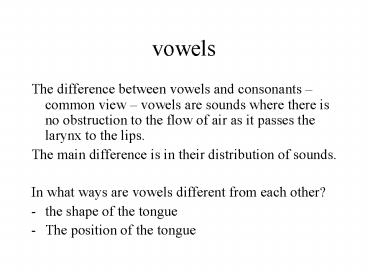vowels - PowerPoint PPT Presentation
1 / 9
Title:
vowels
Description:
... no obstruction to the flow of air as it passes the larynx to the lips. ... 2. Spread ~ the corners of the lips move away from each other, like smiling [i] ... – PowerPoint PPT presentation
Number of Views:96
Avg rating:3.0/5.0
Title: vowels
1
vowels
- The difference between vowels and consonants
common view vowels are sounds where there is no
obstruction to the flow of air as it passes the
larynx to the lips. - The main difference is in their distribution of
sounds. - In what ways are vowels different from each
other? - the shape of the tongue
- The position of the tongue
2
Shape and position of the tongue
- The vertical distance between the upper surface
of the tongue and the palate. - The part of the tongue, between the front and
back, which is raised the highest. - Example i see - the tongue is held up
close to the roof of the mouth - ae cat - more space btw surface of the
tongue and palate
3
Front back close - open
- difference between i and ae is the
difference of tongue height. - i is a relatively close vowel and ae is a
relatively open vowel - in i and ae front part of the tongue is
raised, -comparatively front vowels - in a calm the back of the tongue is the
highest point - back vowel (refer trans 1 2)
4
Cardinal vowels a standard reference
systemprimary cardinal vowels the vowels that
are most familiar to European speakers.
- (refer trans 2)
- i as close and as front as possible to make
a vowel without obstructing the flow of air - a the most open and back vowel
- u fully close and back
5
Another variable of vowel quality is lip rounding.
- 1. Rounded where the corners of the lips
are brought towards each other and the lips are
pushed forward u - 2. Spread the corners of the lips move
away from each other, like smiling i - 3. Neutral lips stay neutral. Like saying
er
6
Tutorial activities
- Discuss English short vowels as presented in the
cardinal charts on pages 15 16 (Roach) - Exercises on page 18.
- Discuss English long vowels as presented in the
charts on pages19 20 - What are tense lax vowels?
- Exercises on page 26
7
Diphthongs
- A movement of vowels glide from one vowel to
another - The first part is much longer and stronger than
the second. - Example ai eye, I - a is
pronounced much longer and stronger than I - Total number of diphthongs are 8. (refer trans 3)
8
Three groups of diphthongs
- Centring the centring diphthongs glide towards
the (schwa) vowel (which is in the centre of
the cardinal chart) - The closing diphthongs end with a glide towards a
closer vowel a glide from a relatively more
open towards a relatively more close vowel. - ending in i
- ending in u (diff. Sym!)
9
triphthongs
- Most complex vowel type
- A glide from one vowel to another and then toa
third, all produced rapidly without interruption. - Example hour
- Triphthongs composed of the 5 closing
diphthongs with the schwa added to the end. - (refer trans 4)
- the middle of the triphthongs can hardly be
heard, thus causing confusion smts.
























![❤[READ]❤ 2024 Missing Vowels Word Search: 102 Puzzles Large Print Easy to See , Puzzle PowerPoint PPT Presentation](https://s3.amazonaws.com/images.powershow.com/10081752.th0.jpg?_=202407191010)
![get⚡[PDF]❤ 2024 Missing Vowels Large Print: Missing Vowels Word Search Puzzle Books for PowerPoint PPT Presentation](https://s3.amazonaws.com/images.powershow.com/10081753.th0.jpg?_=202407191011)

![READ⚡[PDF]✔ Missing Vowels Word Search: Over 500+ Puzzles Word Search Missing Vowels for PowerPoint PPT Presentation](https://s3.amazonaws.com/images.powershow.com/10088420.th0.jpg?_=20240730027)
![get⚡[PDF]❤ Missing Vowels Word Search: Over 500+ Puzzles Word Search Missing Vowels for PowerPoint PPT Presentation](https://s3.amazonaws.com/images.powershow.com/10089956.th0.jpg?_=20240801037)
![⚡[PDF]✔ Missing Vowels Word Search: Over 500+ Puzzles Word Search Missing Vowels for PowerPoint PPT Presentation](https://s3.amazonaws.com/images.powershow.com/10089957.th0.jpg?_=20240801037)
![⚡Read✔[PDF] Missing Vowels Word Search: Over 500+ Puzzles Word Search Missing Vowels for PowerPoint PPT Presentation](https://s3.amazonaws.com/images.powershow.com/10089958.th0.jpg?_=20240801037)
![❤[READ]❤️ Missing Vowels Word Search: Over 500+ Puzzles Word Search Missing Vowels for PowerPoint PPT Presentation](https://s3.amazonaws.com/images.powershow.com/10089967.th0.jpg?_=20240801038)